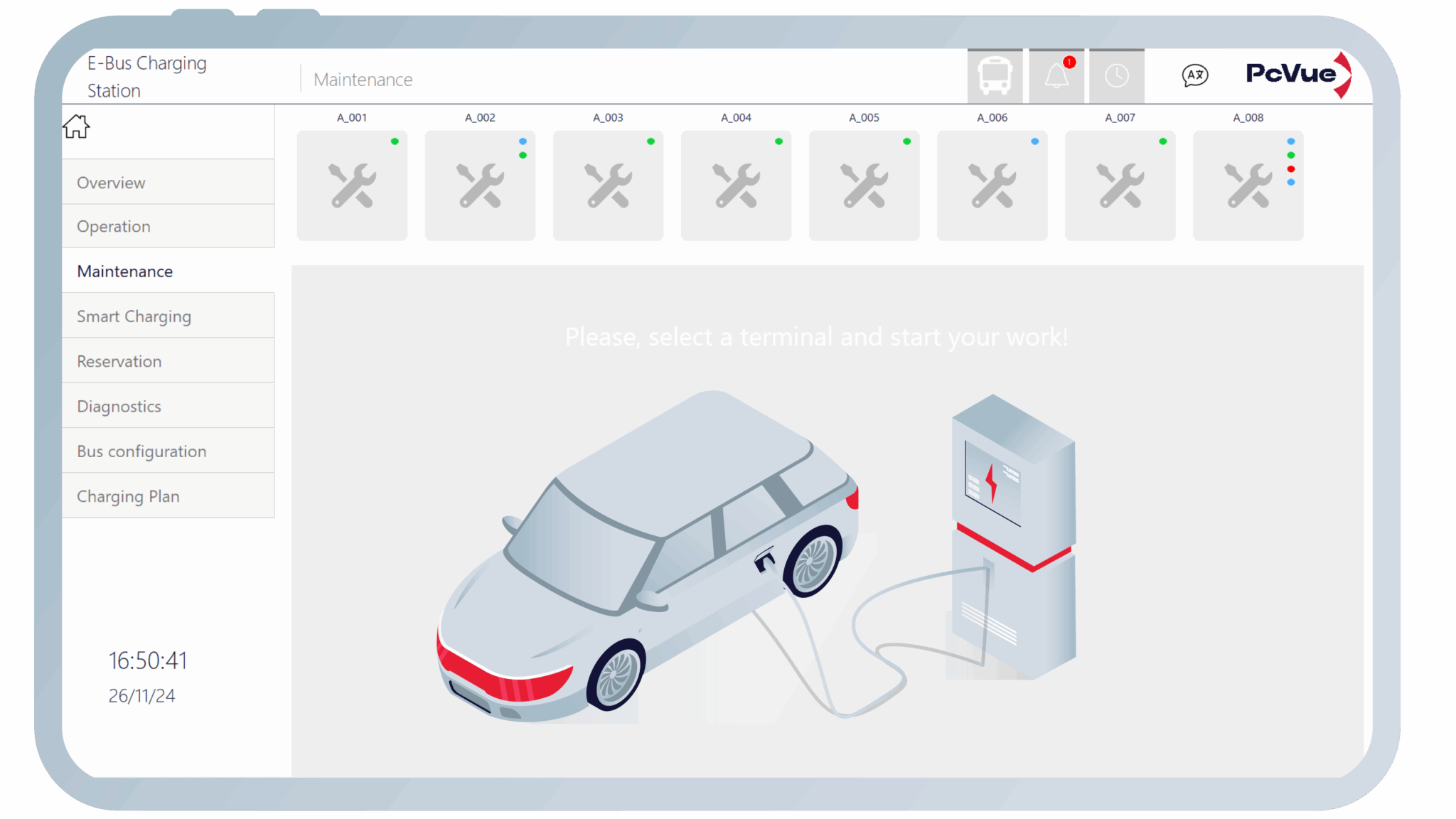
As the transition to electric buses (EV buses) accelerates worldwide, fleet operators, municipalities, and transit agencies are facing a new challenge: ensuring the safety of high-energy lithium-ion batteries. These power sources are essential to cleaner, quieter, and more efficient transportation—but they also come with real risks, especially when it comes to thermal runaway and potential battery fires.
One of the most effective tools in mitigating this risk is a technology that’s already well-established in industrial systems: SCADA.
In this article, we’ll explore how SCADA monitoring systems are being applied to EV bus battery management, especially in detecting and responding to thermal excursions, and how this proactive approach is helping prevent garage fires and danger to human life.

What Is a SCADA System?
SCADA stands for Supervisory Control and Data Acquisition. It’s a centralized system used to monitor and control industrial processes, such as in power plants, manufacturing lines, and utility networks.
In the context of EV buses, a SCADA system gathers real-time data from various sources:
- – Onboard sensors in the bus through telemetry.
- – When present, Battery Energy Storage Systems.
- – Power systems (Substation control, filters, power meters, …).
- – The building through a connection to a BMS or directly to sensors.
- – Finally, charging infrastructure through OCPP.
Combining all these data and displaying them to operators allows them to visualize, analyze, and react to trends or anomalies. Think of it as the “mission control” for a fleet’s energy health and safety.
The Risk: Battery Thermal Excursion and Runaway
Lithium-ion batteries, while generally safe, can experience thermal excursions—events where the temperature rises rapidly and uncontrollably. These are often the precursors to thermal runaway, a chain reaction that can result in battery fires, explosions, or the release of toxic gases.
These events are especially dangerous in closed environments like bus depots or garages, where one vehicle fire can easily spread to others, potentially damaging property, disrupting operations, or worse—endangering lives.
Causes of thermal excursions in EV bus batteries include:
- – Overcharging or deep discharging.
- – Physical damage to cells.
- – Internal short circuits.
- – Manufacturing defects.
- – Excessive ambient heat.
- – Faulty chargers or inverters.
The Solution: SCADA-Powered Early Detection and Reaction

A well-configured SCADA system can be a critical safety layer in battery monitoring. Here’s how:
- Real-Time Thermal Monitoring
SCADA systems can continuously monitor:
- – Battery cell temperatures.
- – Ambient temperatures around buses.
- – Charging temperatures and rates.
- – Cooling system performance.
This live data gives garage operators early warning of abnormal heat trends—before they escalate into critical issues.
- Automated Alarms and Thresholds
The system can be configured with temperature thresholds for warnings and critical alarms. For example:
- – If a battery cell exceeds 50°C, issue a low-level warning.
- – If it exceeds 70°C, trigger a critical alarm, notify staff, and initiate emergency shutdown procedures or evacuations.
- Predictive Analytics and Pattern Recognition
Advanced SCADA platforms can integrate with AI or machine learning tools to analyze historical battery data and predict failure patterns. This helps spot slow-developing thermal issues that might not yet trigger a fixed alarm.
- Integration With Garage Safety Systems
SCADA can be linked with:
- – Ventilation systems to extract heat or smoke.
- – Fire suppression systems.
- – Automatic charger shut-off switches.
- – Digital access control to limit human entry near at-risk vehicles.
- Fleet-Wide Visibility
Because SCADA systems centralize data, a transit authority or private fleet operator can monitor the entire fleet from a single location. This makes it easy to:
- – Identify which buses are at higher risk.
- – Prioritize maintenance.
- – Optimize charging schedules to reduce battery stress.
- – Improve training and protocols for garage staff.
Real-World Benefits: Safety, Uptime, and Trust
Deploying SCADA for EV battery thermal monitoring isn’t just about avoiding worst-case scenarios (though that’s reason enough). It also brings tangible operational and business benefits.
Improved Safety for Staff and Facilities
Early detection of thermal excursions helps prevent explosions, fires, or toxic exposure, especially in densely packed indoor garages where multiple buses are charging or parked.
Reduced Downtime
By catching problems early, SCADA helps reduce:
- – Costly emergency repairs
- – Bus replacements due to fire damage
- – Service disruptions from depot closures
Better Battery Life and ROI
Monitoring charge cycles, temperatures, and anomalies helps extend the usable lifespan of EV batteries, which are among the most expensive components in an electric bus.
Regulatory Compliance and Insurance
With fire and safety codes tightening around EV infrastructure, SCADA can document compliance, provide incident logs, and support insurance claims. It’s also increasingly being considered a best practice or even a requirement by municipalities and transit regulators.
Why Now?
With the rapid growth in EV adoption, the number of EV buses in operation is increasing exponentially—and so is the volume of energy stored in garages overnight. Yet many depots still rely on basic monitoring tools—or worse, no centralized monitoring at all.
Recent high-profile EV bus depot fires (such as those in Paris, London, and Philadelphia) have brought this issue into the spotlight. These incidents, in many cases, could have been avoided with better temperature monitoring and early alerts.
Conclusion: SCADA Is a Silent Guardian for EV Safety
- As EV buses become a mainstay of modern transit, the responsibility to manage their unique risks grows with them. SCADA systems offer a proven, scalable, and proactive approach to ensuring safety—especially when it comes to monitoring and reacting to battery thermal excursions. When integrated properly, SCADA isn’t just a dashboard—it’s a guardian system protecting people, assets, and operations. For any transit agency

